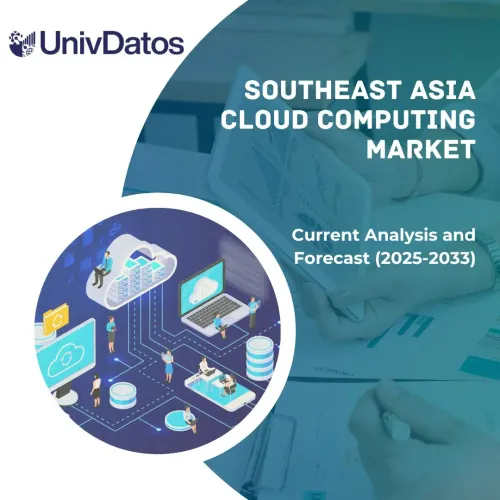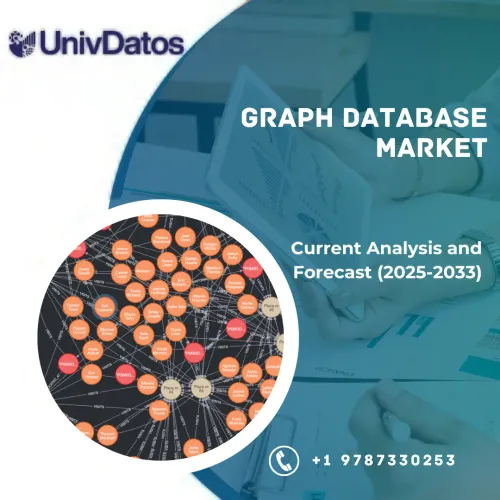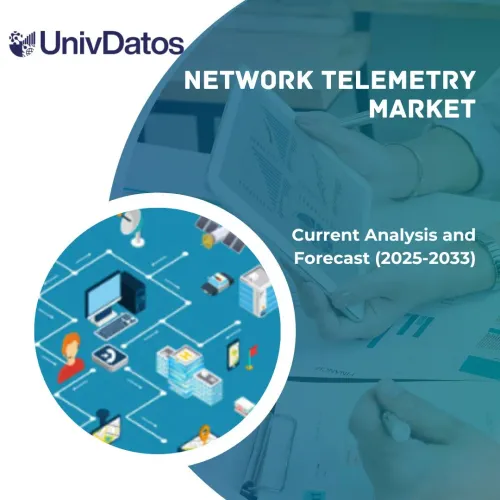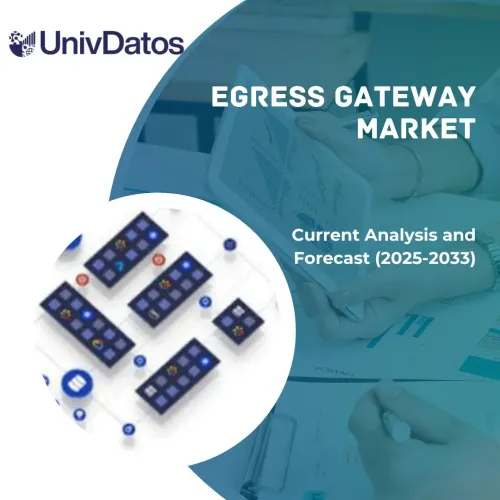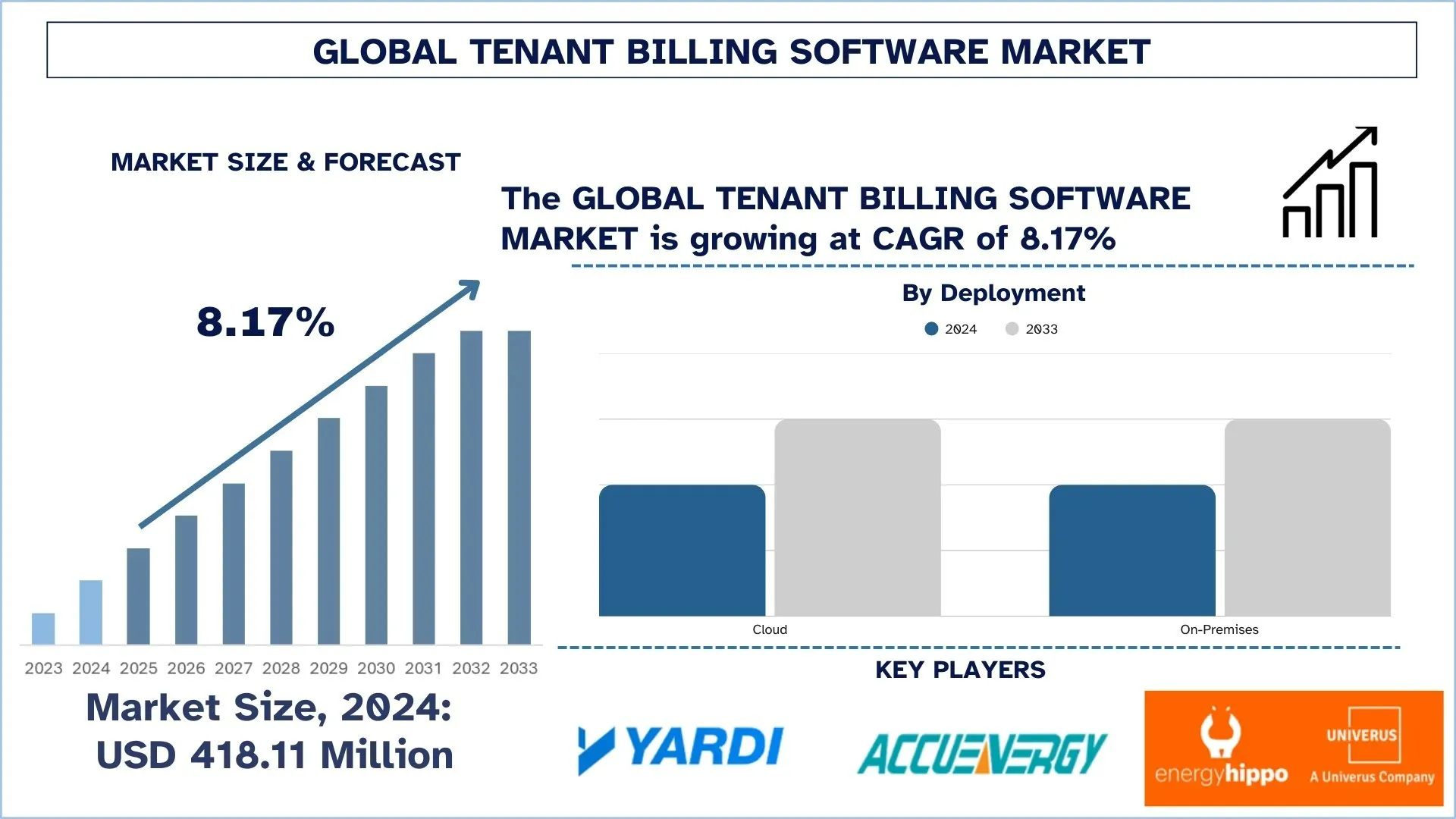
全球租户计费软件市场规模与预测
2024年,全球租户计费软件市场估值为 4.1811 亿美元,预计在预测期内(2025-2033 年)将以约 8.17% 的稳健复合年增长率增长,这归因于商业和住宅综合体的增加,以及云计算的进步和对高效物业管理解决方案的需求,正在推动对租户计费市场的需求。
租户计费软件市场分析
租户计费软件在物业管理领域越来越受欢迎,因为该软件有助于简化和自动化繁琐的租赁、公用事业和其他收费服务的流程。这种软件将几个建筑系统集成到一个完整的系统中,与通常包括手动计算和不同分散系统的传统方式相比,这是一个明显的优势。再加上对房地产高效管理、城市化以及房地产商业和住宅领域数字化转型的日益增长的需求,这些因素成为进一步需求租户计费软件的催化剂。云平台(如 SaaS 模式)的可用性和先进的数据分析能力可以赋予这些系统必要的可扩展性和可靠性功能,以及实时数据处理,因此它们可以更好地处理现代物业管理的动态需求。世界各国及其监管机构已经在收紧对租户权利和金融交易的控制,因此有必要采用精心设计的软件解决方案,以确保计费的合规性和准确性。
全球租户计费软件市场趋势
本节讨论了影响全球租户计费软件市场各个细分市场的关键市场趋势,这些趋势是由我们的研究专家团队发现的。
人工智能和机器学习集成
人工智能的出现正在重新定义物业数据解读。用于租户计费的人工智能和人工智能软件利用历史使用数据来预测即将到来的公用事业成本,识别与正常消费行为的偏差(如泄漏或异常高消费),并提前提出预防措施。Gridium 是一家位于美国的基于“人工智能”的电力收费平台,旨在通过预测消费量和检测超额索赔中的异常值来安排维护,从而帮助管理人员。这会将计费从被动会计职能转变为建筑智能和租户参与的主动组成部分。
租户计费软件行业细分
本节分析了《全球租户计费软件市场报告》中每个细分市场的关键趋势,以及 2025-2033 年全球、区域和国家/地区的预测。
基于云的租户计费软件市场在租户计费软件市场中占据主导地位
按部署方式划分,租户计费软件市场分为云端和本地部署。2024 年,基于云的租户计费软件市场占据了市场主导地位,预计在整个预测期内将保持其领先地位。与世界上现有的本地部署安装相比,转向基于云的解决方案是一种经济、可扩展且易于实施的替代方案,这些安装通常需要高额的初始投资和维护成本。基于云的部署非常灵活,因此适合动荡的房地产市场,在房地产市场中可以轻松进行更新,并且可以集成到其他基于云的物业管理系统中。商业和住宅楼宇的多物业、多区域管理正迅速倾向于使用云来从单一平台增强其运营。此外,美国《萨班斯-奥克斯利法案》等更严格的监管合规诱导性法规要求风险较高的财务报告标准和数据准确性,通过启用云的软件可以更无缝地满足这些法规,从而实现实时更新和更严格的数据安全合规性。促成该细分市场增长的一些因素包括非住宅部门(商业房地产)以及多户住宅和学生住宿部门的需求增加,由于其固有的效率和可扩展性重点,这些部门正在使云部署能够增加其客户群。通常,在整个生命周期内,云解决方案的成本比本地解决方案低 20% 到 40%,这反映在更新、可扩展性和 IT 人员的减少上。
住宅类别在租户计费软件市场中占据最大的市场份额。
按应用划分,租户计费软件市场分为住宅和商业。住宅类别在 2024 年占据最大的市场份额。该细分市场增长背后有几个驱动因素,例如多单元住宅物业的复杂管理以及公用事业和租金计费要求效率低下。随着全球住宅租赁市场的扩张——并且市场主要由于城市化和“租赁胜过购买”的文化而发展——对租户计费解决方案的需求不断增长,这将有助于简化经常性付款、保证金和维护费用的管理,例如,旧金山新建的湾景花园等大型住宅楼现在拥有先进的租户计费软件来照顾数百名居民的多样性——从而表明住宅环境中即将出现向自动化解决方案转变的趋势。这些平台允许物业经理轻松地将计费与其他租户服务集成,从而通过清晰透明的计费和付款选项提高租户满意度和保留率。改进的技术支持移动支付和在线租户门户,使这些系统在现代住宅物业的管理中不可或缺。此外,推动清晰公平的计费实践的新法规以及转向所有事物都在可持续生活中的平等,为此,公用事业必须根据使用情况进行核算和计费——每个使用公用事业的人——构成了推动住宅租户计费软件采用的驱动因素。
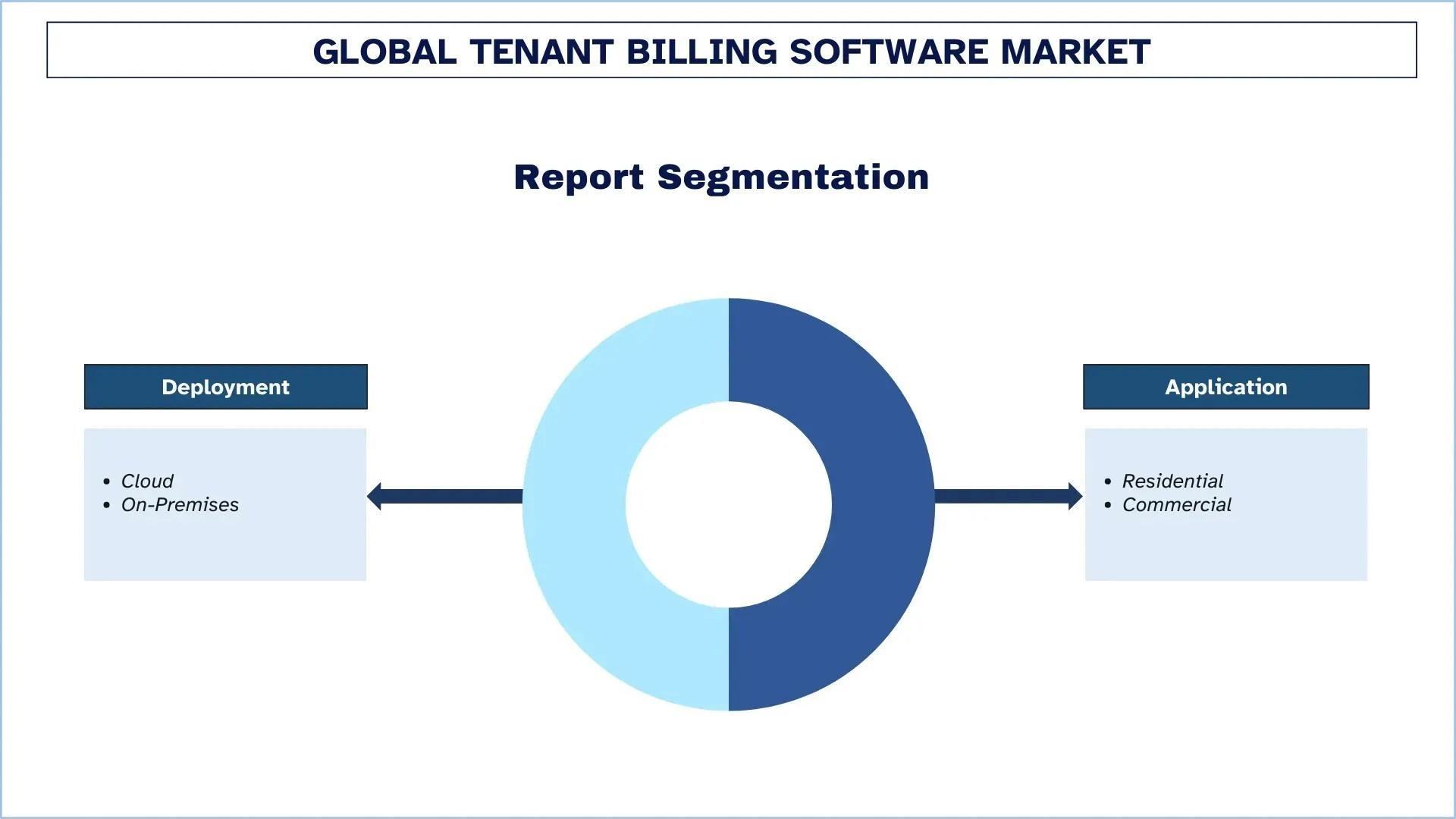
北美地区在全球租户计费软件市场中占据主导地位
北美地区在租户计费软件市场中占据主导地位,预计在预测期内也将表现出同样的趋势。该地区在市场中的主导地位可归功于一些重要因素,如技术导向、房地产市场的成熟度以及围绕物业管理和财务透明度的严格监管规定。美国和加拿大快速的数字化转型是采用此类复杂租户计费解决方案的一个突出因素。北美物业经理和房东现在倾向于基于云的解决方案,这些解决方案是安全的、可扩展的,并且符合当地法律,如《公平住房法》和各种州特定的房东-租户法律,要求客户认真跟踪财务和通信。此外,北美大多数城市的城市化趋势已扩展到多户住宅和混合用途开发项目,需要对公用事业和服务费进行适当的管理。纽约、多伦多和旧金山等城市中心对智能建筑的投资不断增加,也对租户计费系统的接受施加了巨大压力,这些系统可以与智能电表和物联网设备集成,以提供实时数据分析和公用事业管理。
2024 年,美国在北美租户计费软件市场中占据主导地位
关键驱动因素包括智能建筑的快速发展、严格的能源效率要求以及对多租户物业公用事业成本分配透明度日益增长的需求;这些因素推动了美国的租户计费软件行业的创新和发展。对房地产科技(proptech)和可持续建筑举措的投资促进了对高级计费解决方案的需求,以实现分表自动化、最大限度地减少运营效率低下并提高租户满意度。此外,遵守当地能源基准法律(即纽约市当地法律 88)以及对 ESG(环境、社会和治理)合规性的关注迫切需要在美国实现商业、住宅和混合用途开发项目的租户计费系统自动化。目标是通过对人工智能分析、云集成和物联网连接的大量投资,提供可扩展、合规且用户友好的计费解决方案,以充分满足国内和国外标准,并得到美国领先软件提供商的支持。美国租户计费软件市场一直处于创新、效率和适应法规的前沿,因此加强了其作为全球租户计费软件领导者的地位,这归功于成熟的房地产科技公司和灵活的初创公司的组合,所有这些公司都寻求改进实时数据跟踪、报告的可定制性以及与智能建筑系统的集成。
租户计费软件竞争格局
全球租户计费软件市场竞争激烈,拥有多家全球和国际市场参与者。主要参与者正在采取不同的增长战略来增强其市场地位,例如合作伙伴关系、协议、合作、新产品发布、地域扩张以及并购。

顶级租户计费软件公司
市场中的一些主要参与者包括 Yardi Systems, Inc.;Accuenergy Inc.;Energy Hippo, Inc. (A Univerus Company);AppFolio, Inc.;Buildium, A RealPage Company;Enertiv, Inc.;Honeywell International Inc.;Entronix;MRI Software LLC;和 WellStat。
租户计费软件市场的最新发展
- 2024 年 10 月,AppFolio 推出了新的生成式人工智能平台 Realm-X,该平台通过集成优化了物业管理任务。Realm-X 包括用于自动化报告生成、供应商通信等的 Assistant;用于通过 AI 增强的收件箱与居民高效沟通的 Messages;以及 Flows,这是一个自动化所有标准操作的流程和工作流引擎。总的来说,它们可以帮助物业经理每周节省超过 10 个小时的交易时间。AppFolio 还推出了 FolioSpace™,这是一个增强的下一代居民体验平台,它将整合从应用程序到续订的服务,以提升居民的参与度和满意度。
- 2024 年 9 月,RealPage 对其收入管理软件进行了增强,允许客户将非公开竞争对手的数据从租金建议中排除。此举是为了响应旧金山的一项限制使用此类数据的法令。RealPage 声称,其软件在使用公共数据的场景中仍然有价值,并且它可以适应多种法律要求。该公司还表示,关注非公开数据并不能解决该市的住房负担能力问题,这些问题源于严重的供应短缺。RealPage 仍然致力于为其客户提供合规且有效的定价解决方案。
- 2024 年 6 月,Honeywell 推出了其 Connected Power 解决方案,该解决方案专为建筑管理人员设计,用于插头级别的能源使用监控和控制,甚至包括插入式设备(如自动售货机和咖啡机在非工作时间仍插着电源)造成的浪费。它与现有基础设施配合使用,通过数字仪表板进行集中管理。它根据可验证的入住情况自主控制插座,并为潜在的安全问题提供警报,使其成为有效的节能措施和安全措施。它允许用户与 Honeywell Forge 集成,以实现跨多个物业的完整能源管理。
全球租户计费软件市场报告覆盖范围
详细信息 | |
基准年 | 2024 |
预测期 | 2025-2033 |
增长动力 | 以 8.17% 的复合年增长率加速增长 |
2024 年市场规模 | 4.1811 亿美元 |
区域分析 | 北美、欧洲、亚太地区、世界其他地区 |
主要贡献区域 | 预计北美地区在预测期内将占据市场主导地位。 |
涵盖的主要国家/地区 | 美国、加拿大、德国、英国、西班牙、意大利、法国、中国、日本和印度 |
分析的公司 | Yardi Systems, Inc.;Accuenergy Inc.;Energy Hippo, Inc. (A Univerus Company);AppFolio, Inc.;Buildium, A RealPage Company;Enertiv, Inc.;Honeywell International Inc.;Entronix;MRI Software LLC;和 WellStat |
报告范围 | 市场趋势、驱动因素和限制因素;收入估算和预测;细分分析;需求和供应侧分析;竞争格局;公司简介 |
涵盖的细分市场 | 按部署方式;按应用;按地区/国家 |
购买租户计费软件市场报告的理由:
- 该研究包括经过认证的关键行业专家确认的市场规模和预测分析。
- 该报告简要概述了整个行业的业绩。
- 该报告涵盖对主要行业同行的深入分析,主要侧重于主要业务财务、类型组合、扩张战略和最新发展。
- 详细考察了行业中普遍存在的驱动因素、限制因素、主要趋势和机遇。
- 该研究全面涵盖了不同细分市场的市场。
- 深入的行业区域层面分析。
定制选项:
可以根据需求或任何其他细分市场进一步定制全球租户计费软件市场。除此之外,UnivDatos 了解到您可能拥有自己的业务需求;因此,请随时与我们联系以获取完全符合您要求的报告。
目录
全球租户计费软件市场分析(2023-2033)的研究方法
我们分析了历史市场、估算了当前市场并预测了全球租户计费软件市场的未来市场,以评估其在全球主要区域的应用。我们进行了详尽的二手研究,以收集历史市场数据并估算当前市场规模。为了验证这些见解,我们仔细审查了大量的发现和假设。此外,我们还与租户计费软件价值链中的行业专家进行了深入的初步访谈。通过这些访谈验证市场数据后,我们采用了自上而下和自下而上的方法来预测整体市场规模。然后,我们采用市场分解和数据三角剖分方法来估算和分析行业细分和子细分市场的市场规模。
市场工程
我们采用数据三角剖分技术来最终确定整体市场估算,并为全球租户计费软件市场的每个细分和子细分市场得出精确的统计数字。我们通过分析各种参数和趋势,包括部署、应用以及全球租户计费软件市场中的区域,将数据分成几个细分和子细分。
全球租户计费软件市场研究的主要目标
该研究确定了全球租户计费软件市场中的当前和未来趋势,为投资者提供战略见解。它突出了区域市场吸引力,使行业参与者能够进入未开发的市场并获得先发优势。该研究的其他量化目标包括:
- 市场规模分析:评估当前市场规模,并预测全球租户计费软件市场及其细分市场的价值(美元)。
- 租户计费软件市场细分:研究中的细分包括部署、应用和区域。
- 监管框架和价值链分析:检查租户计费软件行业的监管框架、价值链、客户行为和竞争格局。
- 区域分析:针对亚太地区、欧洲、北美和世界其他地区等主要区域进行详细的区域分析。
- 公司简介和增长策略:租户计费软件市场的公司简介以及市场参与者为维持快速增长的市场而采取的增长策略。
常见问题 常见问题
Q1:全球租户计费软件市场目前的市场规模及其增长潜力是什么?
2024年全球租户计费软件市场价值为 4.1811 亿美元,预计在预测期内(2025-2033 年)将以 8.17% 的复合年增长率增长。
Q2:哪个细分市场在部署方面占据全球租户计费软件市场份额最大?
基于云的租户计费软件市场占据主导地位,预计在整个预测期内将保持其领先地位。这些解决方案提供经济高效、可扩展且自动化的计费系统,符合商业和住宅物业中不断变化的公用事业法规和能源效率标准。基于云的平台提供实时数据跟踪、与支持物联网的子表的无缝集成以及远程访问功能,这些功能对于处理复杂的多租户计费场景的物业经理来说日益重要。
Q3:全球租户计费软件市场增长的驱动因素有哪些?
• 对高效物业管理的需求不断增长:云技术的广泛采用使租户账单软件更易于访问、更可靠和更具可扩展性,从而满足了物业经理和房东的需求。
• 商业和住宅综合体的兴起:大型住宅和商业综合体的发展,拥有众多租户,因此需要强大的软件来处理复杂的账单周期和服务费分配。
• 法规遵从:围绕租赁协议和租户权利的法规日益收紧,推动了对能够适应区域法律要求的合规账单系统的需求。
Q4:全球租户计费软件市场中涌现的新兴技术和趋势是什么?
• 人工智能和机器学习集成:人工智能的集成允许对租户行为进行预测分析,优化账单流程,并自动解决账单纠纷。
• 移动优化:随着移动设备使用量的增加,租户账单软件变得更加移动友好,允许租户和房东随时随地管理账单。
• 可持续性报告:将公用事业管理和可持续性报告纳入租户账单软件的趋势日益增长,与全球可持续性目标保持一致。
Q5:全球租户计费软件市场的主要挑战是什么?
• 数据安全问题:随着处理的敏感租户数据量不断增加,软件提供商必须确保强大的安全措施,以防止数据泄露。
• 与现有系统集成:确保租户计费软件与其它物业管理系统无缝集成可能具有挑战性,但对于运营效率至关重要。
• 用户抵制采用:由于对软件解决方案的复杂性和成本的认知,一些物业经理和房东可能会抵制过渡到新系统。
Q6:哪个地区主导着全球租户计费软件市场?
北美地区在租户计费软件市场中占据主导地位,预计在预测期内也将保持这种趋势。该地区在市场中的主导地位可归功于几个重要因素,例如技术导向、房地产市场的成熟以及围绕物业管理和财务透明度的严格监管规定。采用此类复杂租户计费解决方案的一个重要因素是美国和加拿大的快速数字化转型。
Q7:全球租户计费软件市场的关键参与者有哪些?
一些领先的租户计费软件公司包括:
• Yardi Systems, Inc.
• Accuenergy Inc.
• Energy Hippo, Inc. (A Univerus Company)
• AppFolio, Inc
• Buildium, A RealPage Company
• Enertiv, Inc.
• Honeywell International Inc.
• Entronix
• MRI Software LLC
• WellStat
Q8:来自其他计费解决方案的竞争如何影响租户计费软件市场?
• 来自手动计费方法的价格竞争:传统电子表格或外包计费服务提供较低的前期成本,对价格敏感的小型房东构成挑战,但租户计费软件在更大规模的投资组合中保持着可扩展性和准确性的优势。
• 集成式物业管理套件的出现:竞争性的一体化平台(例如,Yardi、RealPage)包含基本的计费功能,但独立的租户计费软件由于其专业功能(例如,精细的公用事业跟踪、合规性报告)而保持需求。
• 开放银行和金融科技颠覆:第三方支付应用程序可能会绕过计费软件进行租金收取,但监管要求(例如,公用事业分表法律)维持了对专注合规性的专用解决方案的需求。
Q9:区域监管差异如何影响全球租户计费软件市场?
• 公用事业计费法律差异:分表计量法规(例如,美国州级法规、欧盟能源效率指令)的差异迫使软件定制,增加了跨国供应商的开发成本。
• 数据隐私和本地化障碍:严格的 GDPR(欧洲)或 CCPA(加利福尼亚)合规要求可能会限制基于云的部署模式,从而有利于拥有本地化数据基础设施的区域供应商。
• 税务和账单格式复杂性:特定于辖区的发票要求(例如,欧洲的增值税、亚洲的分级公用事业费率)需要灵活的软件配置,从而为标准化的全球解决方案设置了障碍。
相关 报告
购买此商品的客户也购买了

